Megane
Sport
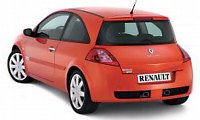 You
might think Renault Sport, with its link to the Formula One team, is a
label for hardcore driving enthusiasts. Yes, Renault Sport Clio is
fulfilling
that demand, but the French car maker also knows that there is even
stronger
demand for a more civilized, more useable hot hatch. This is especially
true when you hike up a segment to the Megane class. The bigger the
car,
the less thrill and the more comfort the buyers want. That's why they
decided
to tune the Megane Sport more civilized than Clio. You
might think Renault Sport, with its link to the Formula One team, is a
label for hardcore driving enthusiasts. Yes, Renault Sport Clio is
fulfilling
that demand, but the French car maker also knows that there is even
stronger
demand for a more civilized, more useable hot hatch. This is especially
true when you hike up a segment to the Megane class. The bigger the
car,
the less thrill and the more comfort the buyers want. That's why they
decided
to tune the Megane Sport more civilized than Clio.
The
first signs of compromise is that Megane Sport is available in not only
the 3-door version but also the 5-door hatchback. Not bad news, because
the 5-door is just 20kg heavier and, to most eyes, looks prettier. In
contrast,
the 3-door hatch has an oddly-shaped C-pillar which won't do good to
rearward
visibility too. Inside, the civilized hot hatch is generously equipped
with leather seats, satellite navigation, cruise control, power
mirrors,
automatic headlamps and wipers, tire pressure monitor, Xenon lights,
card
entry, ESP stability control…. weight reduction is obviously not in its
agenda.
Pulling
as much as 1355kg (or 1375kg for 5-door), the Megane Sport needs a
strong
powerplant. Turbocharging is the obvious solution. Take the 2.0
low-pressure
turbo engine from Vel Satis and Laguna, fit a high-pressure twin-scroll
turbocharger, stronger pistons and crankshaft, tune the ECU and
exhaust,
here comes a 225 horsepower engine. That's more than direct rival Ford
Focus RS and Honda Civic Type R. Torque is not short of either, with
90%
of the maximum 221 lbft available from 2000rpm all the way to
6000rpm.
On
the road, the Megane Sport is really quick and tractable. Its power
delivery
is smooth and strong, performance is higher yet easier to access than
the
aforementioned rivals. Yes, the Nissan-supplied 6-speed manual gearbox
is a little long-winded and imprecise, but the cleverly chosen ratios
compensates
with non-interrupted acceleration. Push it, it can reach 60mph from
rest
in just 6 seconds flat and 100mph in a little over 15 seconds. That
places
it closer to the league of Alfa 147GTA than its own segment.
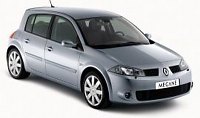 As
for chassis, apart from the usual stiffening of suspension setting,
wider
tires, bigger wheels and brakes etc., Renault Sport specially modified
the steering geometry, relocating the mounting points of steering rack
such that the steering axis is now independent of the front suspension
geometry. For what? to eliminate torque steer, obviously. As
for chassis, apart from the usual stiffening of suspension setting,
wider
tires, bigger wheels and brakes etc., Renault Sport specially modified
the steering geometry, relocating the mounting points of steering rack
such that the steering axis is now independent of the front suspension
geometry. For what? to eliminate torque steer, obviously.
In
terms of torque steer, yes, the modification is successful. We won't
say
it is completely free of torque steer (note that it does not employ any
LSD), but unless you push it very hard in corner it won't upset you.
Nevertheless,
in terms of feel the steering is as flawed as it used to be. Remember,
the whole Megane range is equipped with electric power steering, a
thing
we used to criticize so much. So far, only Volkswagen and Honda have
developed
some decent (but not great) electric steering systems. In the Megane
Sport,
you can feel the weight has been increased, but where is the feel?
When
you drive the car within 80% of its performance envelop, the Megane
seems
like a great driver's car. The comfort-biased suspension absorbs bumps
nicely. The chassis corners accurately, with good reserve of grip and
stopping
power. Adding to that superb engine, this package can put smile on the
driver's face.
But
squeeze the last 20% and its body control immediately collapses. It
resists
to corner as swiftly as Focus RS or smaller hot hatches. The roll, the
lack of sharp response, the understeer discourage you to exploit the
reserved
energy of its engine. Moreover, the mandatory ESP always guard against
any lift-off oversteer. In other words, no much fun.
Ridiculously,
this civilized hot hatch is assembled in the ex-Alpine Dieppe factory
alongside
Renault Sport Clio V6. When I think of the great A110, GTA and A610
that
rolled off the factory from the 60's to the early 90s, I can't help
sighing.
|
 There
are only two car design chiefs in the world dare to break the mould -
BMW’s
Chris Bangle and Renault’s Patrick Le Quement. While Chris Bangle
always
received criticism, Patrick Le Quement seems more successful. Le
Quement’s
styling revolution comes step by step - in the beginning, the Clio
introduced
just a new face, then the Laguna II introduced a coupe-like shape.
Avantime
was the first real revolution, which pioneered a new body shape,
although
it was just a small-scale experiment. Vel Satis brought the experiment
to larger scale, but unfortunately the execution was very
disappointing.
Nevertheless, Le Quement finally completed his styling revolution in
the
Megane II, which is easily the most revolutionarily-styled family
hatchback
for 2 or 3 decades.
There
are only two car design chiefs in the world dare to break the mould -
BMW’s
Chris Bangle and Renault’s Patrick Le Quement. While Chris Bangle
always
received criticism, Patrick Le Quement seems more successful. Le
Quement’s
styling revolution comes step by step - in the beginning, the Clio
introduced
just a new face, then the Laguna II introduced a coupe-like shape.
Avantime
was the first real revolution, which pioneered a new body shape,
although
it was just a small-scale experiment. Vel Satis brought the experiment
to larger scale, but unfortunately the execution was very
disappointing.
Nevertheless, Le Quement finally completed his styling revolution in
the
Megane II, which is easily the most revolutionarily-styled family
hatchback
for 2 or 3 decades.
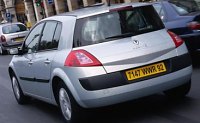 The
most special about Megane II is a dramatic tail. Evolving from
Avantime,
the tail features a near-vertical rear window and a curvy boot lid
extended
out to the extent that the car looks like a 2-and-a-half-box car.
Combine
with the strong shoulder line and clean graphical details, the Megane
looks
like a piece of sculpture. While conventional hatchbacks are 2D
tin-boxes,
the Megane is a 3D sculpture. Some may argue that such a tail design
brings
no benefit to cargo volume, or even deteriorates that, but here I am
fully
agree with Le Quement’s view: it’s time to have a change. For a special
styling, a little bit (if not too much) sacrifice in practicality is
worthwhile.
No wonder some designers said the Megane will influence all future
family
hatch designs and take the industry into "post-Megane era".
The
most special about Megane II is a dramatic tail. Evolving from
Avantime,
the tail features a near-vertical rear window and a curvy boot lid
extended
out to the extent that the car looks like a 2-and-a-half-box car.
Combine
with the strong shoulder line and clean graphical details, the Megane
looks
like a piece of sculpture. While conventional hatchbacks are 2D
tin-boxes,
the Megane is a 3D sculpture. Some may argue that such a tail design
brings
no benefit to cargo volume, or even deteriorates that, but here I am
fully
agree with Le Quement’s view: it’s time to have a change. For a special
styling, a little bit (if not too much) sacrifice in practicality is
worthwhile.
No wonder some designers said the Megane will influence all future
family
hatch designs and take the industry into "post-Megane era".
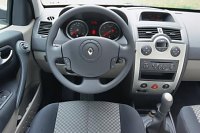 Nevertheless,
in heart and bones the Megane II is actually very conventional.
Although
the platform is all-new, it still rides on MacPherson struts and
torsion-beam
axle suspensions. It is a large car in the segment, having a long
wheelbase
of 2620mm (marginally longer than Ford Focus). However, the rear cabin
is actually very tight, a strange thing. Tall people will find legroom
limited. Like the Vel Satis, Megane didn’t materialize its potential
packaging
advantages. Luckily, the cabin is still a nice place to be in, thanks
to
the clean dashboard, high-spec equipment and Volkswagen-matching
high-quality
materials.
Nevertheless,
in heart and bones the Megane II is actually very conventional.
Although
the platform is all-new, it still rides on MacPherson struts and
torsion-beam
axle suspensions. It is a large car in the segment, having a long
wheelbase
of 2620mm (marginally longer than Ford Focus). However, the rear cabin
is actually very tight, a strange thing. Tall people will find legroom
limited. Like the Vel Satis, Megane didn’t materialize its potential
packaging
advantages. Luckily, the cabin is still a nice place to be in, thanks
to
the clean dashboard, high-spec equipment and Volkswagen-matching
high-quality
materials. 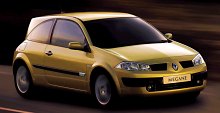 In
contrast, powertrain is good by class standard. Renault’s 1.6-litre
(115hp)
and 2.0-litre (136hp) petrol engines are now added with continuous
variable
valve timing thus both are torquey enough, with 90% of maximum torque
from
just 2000rpm. In the diesel side, 1.5dCi (80hp) is obviously
underpowered
for the Megane, but 1.9dCi (from Laguna) is fast and perfectly refined.
120hp and 199lbft mating with a slick 6-speed manual gearbox (supplied
by Nissan) guarantees a sub-10 seconds 0-60mph acceleration as well as
strong sales.
In
contrast, powertrain is good by class standard. Renault’s 1.6-litre
(115hp)
and 2.0-litre (136hp) petrol engines are now added with continuous
variable
valve timing thus both are torquey enough, with 90% of maximum torque
from
just 2000rpm. In the diesel side, 1.5dCi (80hp) is obviously
underpowered
for the Megane, but 1.9dCi (from Laguna) is fast and perfectly refined.
120hp and 199lbft mating with a slick 6-speed manual gearbox (supplied
by Nissan) guarantees a sub-10 seconds 0-60mph acceleration as well as
strong sales.  You
might think Renault Sport, with its link to the Formula One team, is a
label for hardcore driving enthusiasts. Yes, Renault Sport Clio is
fulfilling
that demand, but the French car maker also knows that there is even
stronger
demand for a more civilized, more useable hot hatch. This is especially
true when you hike up a segment to the Megane class. The bigger the
car,
the less thrill and the more comfort the buyers want. That's why they
decided
to tune the Megane Sport more civilized than Clio.
You
might think Renault Sport, with its link to the Formula One team, is a
label for hardcore driving enthusiasts. Yes, Renault Sport Clio is
fulfilling
that demand, but the French car maker also knows that there is even
stronger
demand for a more civilized, more useable hot hatch. This is especially
true when you hike up a segment to the Megane class. The bigger the
car,
the less thrill and the more comfort the buyers want. That's why they
decided
to tune the Megane Sport more civilized than Clio.
 As
for chassis, apart from the usual stiffening of suspension setting,
wider
tires, bigger wheels and brakes etc., Renault Sport specially modified
the steering geometry, relocating the mounting points of steering rack
such that the steering axis is now independent of the front suspension
geometry. For what? to eliminate torque steer, obviously.
As
for chassis, apart from the usual stiffening of suspension setting,
wider
tires, bigger wheels and brakes etc., Renault Sport specially modified
the steering geometry, relocating the mounting points of steering rack
such that the steering axis is now independent of the front suspension
geometry. For what? to eliminate torque steer, obviously.
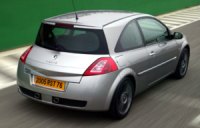 Obviously,
British drivers demand more driving fun from their hot hatches than
other European, that's why Renault specially created Megane Trophy for
the UK market. Basically, the car is a Renault Sport Megane with
sportier chassis setup. It retains the excellent 225hp 2-litre 16V
turbo engine. The chassis modifications are introduced to answer the
criticism that the Megane Sport was too civilized to handle.
Obviously,
British drivers demand more driving fun from their hot hatches than
other European, that's why Renault specially created Megane Trophy for
the UK market. Basically, the car is a Renault Sport Megane with
sportier chassis setup. It retains the excellent 225hp 2-litre 16V
turbo engine. The chassis modifications are introduced to answer the
criticism that the Megane Sport was too civilized to handle.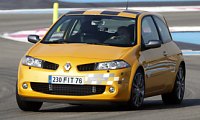 Every
year Renault
Sport Megane introduces a small revision to sustain sales. The latest
revision is called "Megane 230 F1 Team R26", named after Renault's
championship-winning formula one race car.... Don't laugh, although it
has nothing in common with the F1 car, its handling is hugely improved
over the last Megane Trophy / Cup. This must thanks to the addition of
a limited slip differential between the front wheels.
Every
year Renault
Sport Megane introduces a small revision to sustain sales. The latest
revision is called "Megane 230 F1 Team R26", named after Renault's
championship-winning formula one race car.... Don't laugh, although it
has nothing in common with the F1 car, its handling is hugely improved
over the last Megane Trophy / Cup. This must thanks to the addition of
a limited slip differential between the front wheels.  Apart
from the new found handling capability, the R26 retains the absorbent
ride quality of its predecessor because the suspension tuning is
unchanged. This mean you can enjoy its good handling on bumpy B-roads
as well as on glass-smooth motorway.
Apart
from the new found handling capability, the R26 retains the absorbent
ride quality of its predecessor because the suspension tuning is
unchanged. This mean you can enjoy its good handling on bumpy B-roads
as well as on glass-smooth motorway. The
latest battle between arch-rivals PSA and Renault can be seen in the
coupe-cabriolet
market. Just weeks after the debut of Peugeot 307CC (which stands for
"Coupe
Cabriolet"), Renault strike back with Megane Coupe Cabriolet. Not only
fall into the same segment, both cars employ a similar electric folding
hard roof. A direct combat seems inevitable.
The
latest battle between arch-rivals PSA and Renault can be seen in the
coupe-cabriolet
market. Just weeks after the debut of Peugeot 307CC (which stands for
"Coupe
Cabriolet"), Renault strike back with Megane Coupe Cabriolet. Not only
fall into the same segment, both cars employ a similar electric folding
hard roof. A direct combat seems inevitable.